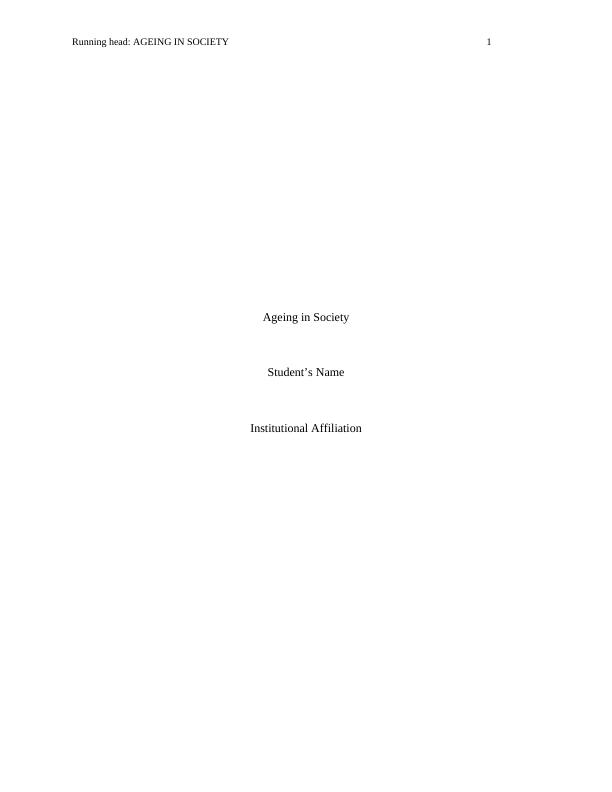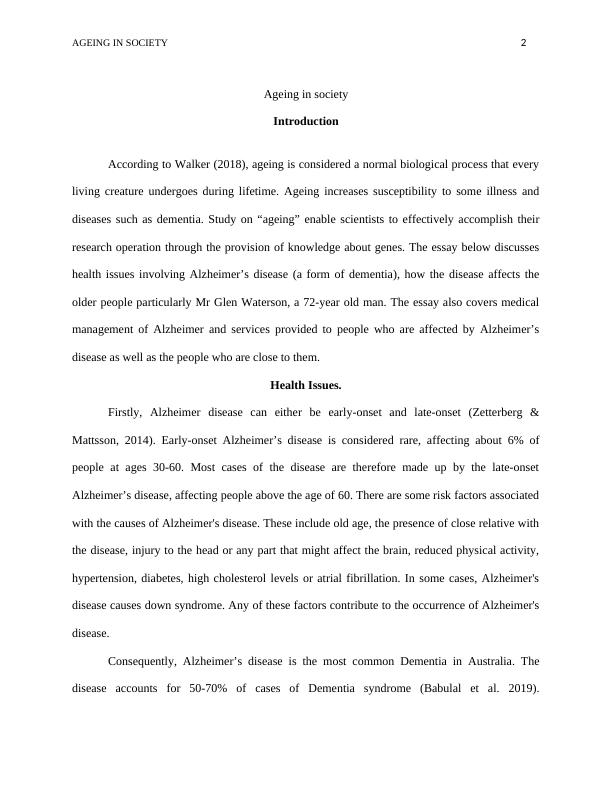Ageing in Society
Added on 2023-04-21
10 Pages2912 Words227 Views
Running head: AGEING IN SOCIETY 1
Ageing in Society
Student’s Name
Institutional Affiliation
Ageing in Society
Student’s Name
Institutional Affiliation

AGEING IN SOCIETY 2
Ageing in society
Introduction
According to Walker (2018), ageing is considered a normal biological process that every
living creature undergoes during lifetime. Ageing increases susceptibility to some illness and
diseases such as dementia. Study on “ageing” enable scientists to effectively accomplish their
research operation through the provision of knowledge about genes. The essay below discusses
health issues involving Alzheimer’s disease (a form of dementia), how the disease affects the
older people particularly Mr Glen Waterson, a 72-year old man. The essay also covers medical
management of Alzheimer and services provided to people who are affected by Alzheimer’s
disease as well as the people who are close to them.
Health Issues.
Firstly, Alzheimer disease can either be early-onset and late-onset (Zetterberg &
Mattsson, 2014). Early-onset Alzheimer’s disease is considered rare, affecting about 6% of
people at ages 30-60. Most cases of the disease are therefore made up by the late-onset
Alzheimer’s disease, affecting people above the age of 60. There are some risk factors associated
with the causes of Alzheimer's disease. These include old age, the presence of close relative with
the disease, injury to the head or any part that might affect the brain, reduced physical activity,
hypertension, diabetes, high cholesterol levels or atrial fibrillation. In some cases, Alzheimer's
disease causes down syndrome. Any of these factors contribute to the occurrence of Alzheimer's
disease.
Consequently, Alzheimer’s disease is the most common Dementia in Australia. The
disease accounts for 50-70% of cases of Dementia syndrome (Babulal et al. 2019).
Ageing in society
Introduction
According to Walker (2018), ageing is considered a normal biological process that every
living creature undergoes during lifetime. Ageing increases susceptibility to some illness and
diseases such as dementia. Study on “ageing” enable scientists to effectively accomplish their
research operation through the provision of knowledge about genes. The essay below discusses
health issues involving Alzheimer’s disease (a form of dementia), how the disease affects the
older people particularly Mr Glen Waterson, a 72-year old man. The essay also covers medical
management of Alzheimer and services provided to people who are affected by Alzheimer’s
disease as well as the people who are close to them.
Health Issues.
Firstly, Alzheimer disease can either be early-onset and late-onset (Zetterberg &
Mattsson, 2014). Early-onset Alzheimer’s disease is considered rare, affecting about 6% of
people at ages 30-60. Most cases of the disease are therefore made up by the late-onset
Alzheimer’s disease, affecting people above the age of 60. There are some risk factors associated
with the causes of Alzheimer's disease. These include old age, the presence of close relative with
the disease, injury to the head or any part that might affect the brain, reduced physical activity,
hypertension, diabetes, high cholesterol levels or atrial fibrillation. In some cases, Alzheimer's
disease causes down syndrome. Any of these factors contribute to the occurrence of Alzheimer's
disease.
Consequently, Alzheimer’s disease is the most common Dementia in Australia. The
disease accounts for 50-70% of cases of Dementia syndrome (Babulal et al. 2019).

AGEING IN SOCIETY 3
Approximately 160,000 Australians have been affected by Dementia. Australians above 80 years
of age suffer severe dementia, women being at higher risk than men. According to the report
published on 30th July 2016, there has been a decline in the prevalence of dementia in countries
with high incomes. Some statistics also show increasing prevalence in low income countries such
as East Asia (Prince et, al., 2016). Therefore, Australia being a low income nation is at higher
risk of the disease. Hence, Alzheimer's disease is common in Australia and will still affect the
number of old people in the country.
On the same note, Alzheimer’s disease has several impacts on Australia. Johnstone
(2016), reported that Alzheimer’s disease was the second leading cause of deaths in Australia by
2014 after heart diseases. Women are said to be dying of the disease more than men. More
deaths in women are related to the reduction of female hormone production after menopause.
The hormones play a vital role in cardiovascular function and memory. The disease has not only
impacted the individual families but the country as a whole. The government of Australia spent
more than $4.9 billion in 2010 to handle the disease. Such expenditures affect the economic
growth of the nation as more finance is being allocated to curb the disease than to development
projects.
Besides, Alzheimer’s disease has some common symptoms and factors that contribute to
its existence. Gnanamanickam et, al., 2018, highlight the symptoms of Alzheimer’s disease as;
lapses in memory, deteriorating social abilities, unpredictable emotions, difficulties in
remembering recent events, inability to process question, loss of interest in the previously
enjoyed activity and lack of certainty during a conversation. These symptoms progress at
different speeds depending on an individual and the part of the brain affected. The signs,
however, worsen in the time of fatigue, the stress of illness.
Approximately 160,000 Australians have been affected by Dementia. Australians above 80 years
of age suffer severe dementia, women being at higher risk than men. According to the report
published on 30th July 2016, there has been a decline in the prevalence of dementia in countries
with high incomes. Some statistics also show increasing prevalence in low income countries such
as East Asia (Prince et, al., 2016). Therefore, Australia being a low income nation is at higher
risk of the disease. Hence, Alzheimer's disease is common in Australia and will still affect the
number of old people in the country.
On the same note, Alzheimer’s disease has several impacts on Australia. Johnstone
(2016), reported that Alzheimer’s disease was the second leading cause of deaths in Australia by
2014 after heart diseases. Women are said to be dying of the disease more than men. More
deaths in women are related to the reduction of female hormone production after menopause.
The hormones play a vital role in cardiovascular function and memory. The disease has not only
impacted the individual families but the country as a whole. The government of Australia spent
more than $4.9 billion in 2010 to handle the disease. Such expenditures affect the economic
growth of the nation as more finance is being allocated to curb the disease than to development
projects.
Besides, Alzheimer’s disease has some common symptoms and factors that contribute to
its existence. Gnanamanickam et, al., 2018, highlight the symptoms of Alzheimer’s disease as;
lapses in memory, deteriorating social abilities, unpredictable emotions, difficulties in
remembering recent events, inability to process question, loss of interest in the previously
enjoyed activity and lack of certainty during a conversation. These symptoms progress at
different speeds depending on an individual and the part of the brain affected. The signs,
however, worsen in the time of fatigue, the stress of illness.

End of preview
Want to access all the pages? Upload your documents or become a member.
Related Documents
Alzheimer Disease: Clinical Updatelg...
|13
|3277
|403
NRSG136 - The Australian Nursing Statisticslg...
|7
|1859
|46
Developing the Research Question Assignment 2022lg...
|6
|1434
|9
Alzheimer’s Disease Assignmentlg...
|4
|1441
|17
The Pathogenesis of Dementialg...
|12
|3136
|17
Dementia: Risk Factors and Prevention Methodslg...
|8
|1753
|268
